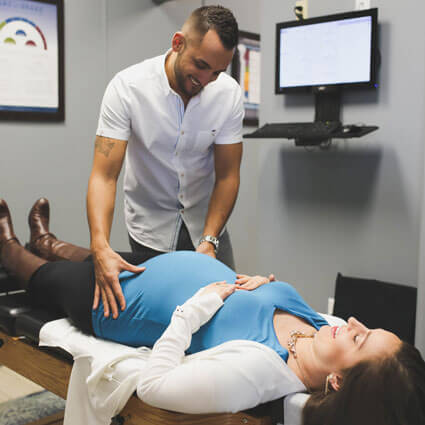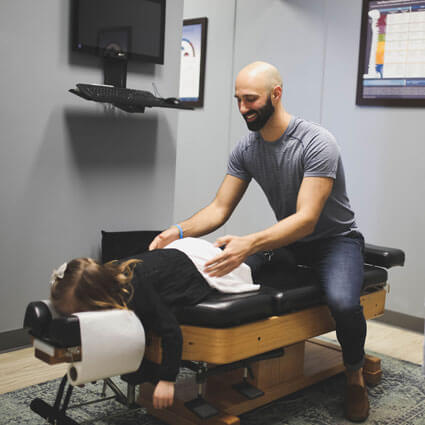Modern Chiropractic
Chiropractic Adjustments Are Essential
Spinal joints that aren’t moving right can choke or irritate nearby nerves. Chiropractic adjustments add motion to these stuck joints, reducing nervous system disruption. Then, health has the best opportunity to return.
Feels Great
Because we rely on adjustments to help your body “RIGHT itself”, we’re highly proficient.
Most patients report a sense of well-being and ease. After all, if adjustments weren’t pleasant, our patients wouldn’t return for the multiple visits needed to retrain their spine!
Many Techniques
We use a number of highly-effective adjusting approaches to help improve spinal biomechanics and reduce nervous system interference. The approach we use is based on our clinical judgment and years of experience. Sometimes a specific, highly-accurate thrust is used. Or an instrument delivers carefully directed energy. Or a slow, constant pressure is used. Several areas may be adjusted, or just one. Sometimes a popping sound is heard.
Torque Release uses a gentle touch and light thrusting by hand or small, hand-held instrument called an Integrator. This low-force adjusting method allows the nervous system to better integrate and understand the new corrective information and to process it throughout the spinal cord and brain.
Imagine that your nervous system has a volume control. If the volume is too loud it causes distortion, with internal organ complaints, musculoskeletal stresses and diminished immune response. Too weak, and your body doesn’t receive critical messages, showing up as sluggishness, reduced performance and poor muscle support. Torque Release looks to correct these problems by normalizing the functioning of the nerves, spinal cord and brain.
After each adjustment, the body is given time to process the change. Correction continues with your body’s movements and breathing. This process teaches and empowers your body to make more corrections. Healing progresses with repeated visits.
The primary intent of Torque Release Technique is to reduce blockages and tension of the entire spinal system, to release trapped, unresolved patterns, facilitate reintegration of the nervous system allowing a greater expression of your health.
Misalignments where the sacrum joins the pelvis (hip) can be quite common during the course of pregnancy. Besides potentially interfering with the baby assuming the normal head-down position in preparation for delivery, it can produce a variety of symptoms in mothers preparing for the culmination of their pregnancy.
The Sacral Misalignment
Developed by the late Larry Webster, D.C., the chiropractic technique he developed and taught chiropractors around the world, helps release stress on the pelvis, relaxing surrounding ligaments and reducing the sacral misalignment to help restore more normal function.
Sacral misalignments may cause the tightening and twisting of pelvic muscles and ligaments, constraining the uterus. The goal of the adjustment is to reduce the effects of misalignment and the associated dysfunction of the sacroiliac joint. The result? Neurobiomechanical function in the sacral/pelvic region is improved, benefiting pregnant mothers or others with sacral misalignments.
High Success Rate
The July/August 2002 issue of the Journal of Manipulative and Physiological Therapeutics reports that 82% of chiropractors using the Webster Technique reported success in reducing the sacral misalignment.
Sometimes when using the Webster Technique, the associated dysfunction of the sacroiliac joint can be reduced with just one adjustment. But usually it takes between three to 10 visits over a several week period.
Because the Webster Technique relies on the inborn intelligence of the mother and baby, there is little risk. The Webster Technique is based on the positive experiences of pregnant patients, the clinical experience of its many practitioners, academic studies on the subject of sacral misalignment and its consequences to proper pelvic function.
Are chiropractic adjustments safe?
Can I adjust myself?
Everyone Benefits
Newborns, infants, children, seniors and even back surgery patients can get adjusted. Naturally, adjustments are tailored to your size, age and particular health issue.
If you’ve been to a chiropractor before and prefer to be adjusted in a particular way, let Dr. Nick know. We want you to relax, enjoy and fully benefit from your chiropractic care. Give us a call today!
CONTACT US »




